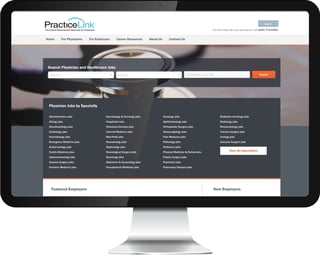
When the to-do list at work keeps growing, it’s tempting to focus your energy on crossing off all the items. The problem with that in recruitment is that your candidates can sense it, and that could send an unintended message that they’re not important.
PracticeLink recently surveyed active and passive candidates in the PracticeLink database and identified 10 things that physicians want from recruiters. By incorporating these into your recruiting method, you can make the candidate feel more welcome while also creating strong connections, building a robust talent pipeline and – most importantly – finding the physicians and advanced practice providers that can heal your community.
1. Visibility in the Recruitment Process

Job seekers want to know where they stand, even if you’re moving forward with another candidate. According to a past LinkedIn survey:
- 59% of professionals want to receive updates.
- 94% want interview feedback if they’re rejected.
- But only 41% received feedback after a rejection.
Providing this extra visibility may take more of your time, but it will benefit the candidate personally and establish the benchmark for them to reach to be considered in the future.
2. Be Human – Get to Know the Candidate

Candidates think their recruiter relationships have become more impersonalized. Effective recruiters take time to get to know their candidates. This makes the candidate feel like more than a name on a list, and it can help you better assess whether they’re a good fit for the organization.
Did you know? You can also identify stronger candidates with PracticeLink’s in-depth candidate interviews.
3. Listen

Passive listening leads to ineffective, inefficient communication. At best, candidates may see this as impersonal. At worst, they may interpret it as disinterest in their wants and needs.
“The thing that annoys me a lot is when a recruiter tries to take a square peg and put it into a round hole. It doesn’t matter to the recruiter what you want or what your requirements are. The recruiter has a job and wants you to fill it,” said a physician from Winston-Salem, North Carolina.
Active listening, on the other hand, shows your concern for their needs and helps you identify relevant follow-up questions. This, in turn, leads to deeper and more beneficial conversations. The best recruiters listen up to twice as much as they speak.
4. Candidates Want to Know About You

While interviews are an opportunity for you to get to know the candidates, be sure they’re also learning about you and the organization you represent. What do you like about the facility? The community? What’s there to do away from the job? These exchanges can help relax the conversation, make you more relatable and give the candidate a better idea of the opportunity overall.
5. Honesty Is the Best Policy

When discussing an opportunity, be sure the information is rooted in facts. Any embellishment or deception will be discovered eventually. For example, don’t try to convince a candidate to consider a role if it doesn’t fit their interests.
“If I tell you I’m not interested in such a reason, don’t keep coming back to me with a hard sell. And don’t put the pressure on by saying, ‘It’s a buyer’s market now,’” said the same surgeon from Winston-Salem. “Good recruiters don’t waste their time with things like that.”
If you think a candidate could be good for a different position, feel free to bring it up, but do so in a way that avoids making the candidate feel pressured.
6. Job Postings That Sizzle

Thirty-one percent of surveyed candidates want more details in job postings. When writing yours, ask yourself what would make you interested in the position. Also, gauge whether it will be understood by someone without the same level of knowledge as you.
Also think about how to use visuals to enhance your message. For example, in the PracticeLink system, you can incorporate logos, images, a slideshow and external links, like YouTube videos, to create more vivid profiles and postings.
7. Be a Resource

Job postings and interviews don’t have to be your only touch points. Take advantage of residency outreach opportunities. Attend specialty conferences and career fairs. Start a blog or share information on social media – anything that shows you’re interested in more than simply filling a position. Even if a candidate isn’t currently interested, they may be later, or they may know someone else who is. Your being a resource will be remembered.
8. Candidates’ Time Matters

Candidates are busy, and so are recruiters. That’s why any communication should still respect their time. Some ways to do this include:
- A simplified, straightforward application process.
- An easy-to-understand call to action so candidates know what to do next.
- A good response time so they’re not left wondering what happened.
- An outlined hiring process so they see the big picture.
9. Don’t Leave Candidates Guessing

As you navigate your recruiting process, you’re bound to experience changes. When they do occur, ask yourself whether that affects your candidates’ expectations. If so, provide them an update and what led to the change. This can help build rapport, even if the information isn’t always positive.
10. Your Job Shouldn’t End with the Hire

Candidates value you even after their signature is on the contract. Both of you have invested time into the relationship. Consider that momentum toward keeping them on staff. If you’re directly involved in your organization’s retention initiatives, continue to build on your relationship and help the physician grow comfortable in their new environment. If another department handles retention, then offer your assistance to help the physician get adjusted, and be involved in their introduction to the retention team while remaining available as a resource during the transition.








